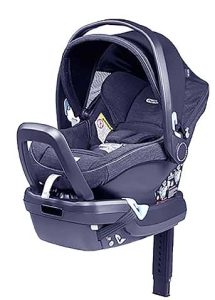Transporting kids in a car can be a challenge, especially in a single-cab truck. Parents need to understand the proper use of rear-facing car seats in single-cab trucks, booster seat laws, and when it is safe for a child to sit in a front seat. I’ll provide specific information here on what you’ll need when using a rear-facing car seat in a single-cab truck, ensuring that you prioritize safety while navigating the unique space constraints of a single-cab truck.
As a Child Passenger Safety (CPS) Technician, I always seek new ways to learn and share my knowledge. Stay tuned for updates on car seat tips, resources and the latest safety recommendations!
Why rear-facing car seats is best?
The American Academy of Pediatrics recommends keeping children in rear-facing car seats until they reach the maximum height or weight limit set by the manufacturer. In a single-cab truck, space can be tight. For example, if your cab truck has a bench seat, ensure the rear seat is installed properly to provide enough room to recline. 
Installation Tips for Rear-facing car seats
Check your vehicle’s manual: Certain vehicles have unique installation procedures.
Use a tether strap: If available, this can help secure the seat more effectively. This provision is also applicable for car seat golf carts.
Many popular single-cab trucks, such as the Ford F-150, offer rear seat belts that can safely accommodate a rear-facing car seat, although space may seem limited.
General guidelines for Rear-facing car seats in single-cab trucks
Children should ideally stay in the back seat until they are at least 13 years old. The rear seat is safer because of the distance from the front airbags, which could pose a hazard in the event of an accident.
If you have an 11-year-old, discuss the importance of staying behind until they are 13 to ensure their safety.
Rear-facing car seat laws
Rear-facing car seat laws on single-cab trucks by state in the United States:
Safety Guidelines: Children should remain in rear-facing car seats until they are at least 2 years old or reach the maximum weight and height limits for the seat recommended by the American Academy of Pediatrics.
State Laws: I’ve seen many states follow similar laws on this matter, requiring children to stay in a rear-facing seat until at least age 2. Some states have exceptions so you must check your specific state’s laws.
In California, children under 2 must be in a rear-facing seat until they weigh 40 pounds and are over 40 inches tall.
Texas law requires children under the age of 4 to be in a car seat or booster seat, but preferably in a rear-facing seat as long as possible.
Always check local laws and guidelines for your specific situation, as well as consult with a certified child passenger safety technician for best practices!
Single-Cab Truck Considerations: In single-cab trucks, space may be limited. If the truck doesn’t have a rear seat, you must have the car seat properly installed in the front seat, which is generally not recommended for rear-facing seats due to airbag concerns. Always disable the airbags when the rear seats are forward
I know that single-cab trucks have fewer car seats to install. Many fit two car seats in the back of a crew cab truck, but you’ll have to judge which seats will fit based on the limited space in a single cab truck.
Some single cabs may be suitable for a thin-profile car seat, such as a Clek Funoff, which accommodates some passengers while complying with safety recommendations.
Do you need to sit in the front seat of a single-cab truck?
Safety recommendations: State laws vary, but generally, children under 12 must sit in the back. However, if space constraints require them to sit in the front, make sure they are in a proper car seat or booster and that the airbag is either turned off or that they sit far enough back to avoid injury.
Conclusion
Carefully consider all aspects of selecting a child seat to navigate car seat safety in a single-cab truck. If you live in North Carolina, understanding the laws there and knowing when it’s safe for a child to sit in the front seat can help ensure your child’s safety on the road.
Follow the guidelines for rear-facing car seats in single-cab trucks, see your vehicle’s manual for specific instructions. Travel safely!
FAQ
Q: Can I put a rear-facing car seat in a single-cab truck?
Ans: You can install a rear-facing seat in the front seat of a single cab truck if the width of the seat or bench supports 85% of the child safety seat, but the airbag must be turned off.
Q: Where is the safest place for the rear-facing car seat in a single cab truck?
Ans: Rear-facing car seats are specially designed for the back seat of a car. The safest place for a child’s car seat is the centre back seat, farthest from the passenger side airbag.

Child Passenger Safety Technician,
I educate parents and caregivers on how to use car seats properly.
I have 8 years of experience in this profession.
Child Passenger Safety Technician- Certified March of 2013.
Special Needs Child Passenger Safety Technician- Certified March of 2014
